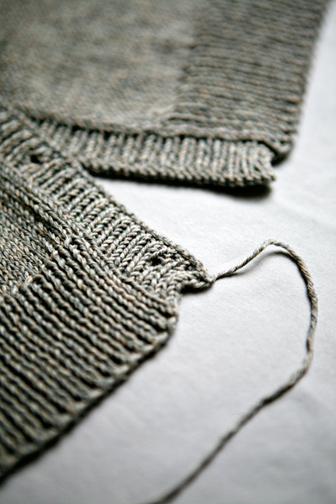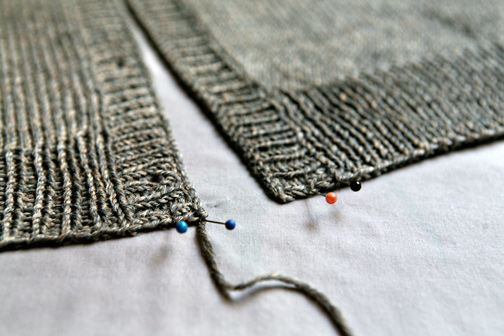Being a fan of 1×1 ribbing is a mixed affair.
On one hand, you end up with a rather sophisticated edging (compared to 2×2, which, IMHO, is less formal, charming but chunky).
But on the other, you end up with this:

I’ve completed both front bands of my little Stockinette St sweater but am really not finished. What’s left?
The taming of the *Bunch*.
You can see that the bottom of the bands, at hem edge, are seriously pulling in, making a curve, looking weird. Now, the band stitches were picked up right to the edge of the hem, and the expectation is that there would be “full-coverage”. But the 1×1 ribbing is very elastic and it naturally draws in if left au naturel.
What’s needed?
B.L.O.C.K.I.N.G.
Now, is it just me or is this an eight letter term (and not a 4-Letter Word!)
But if you spend any amount of time carousing in the millions of projects online, you’ll see that many have something in common: there’s an aversion to blocking out there.
In fact, here’s the Top 10 Knitting Evasions I’ved noticed, over and over, where the smaller the rank, the larger the rankling:
10. Measuring before starting
9. Stockinette St
8. Seed St
7. Making Buttonholes
6. Picking Up Sts
5. Seaming
4. Counting Sts in progress
3. Measuring in progress
2. Blocking
1. Swatching
All of us, at one time or another, just are bitten by the bug and cast on and want to sail away into the sunset with a cool sweater. I’ve done it. There’s passion at work here: to get it going, to wear it, and those little detours make the end journey longer. So one just beelines to the finish line, without a care. (Hmm. Why’s it called the Finish Line?)
What’s kind of weird here, is that all of the above (with the exception of Seed St) are in my sweater!
And even more ironic, most of the above are the stepping stones to a good looking garment.
Witness:

In less than 3 minutes, I’ve tamed the bottom of my button band using 4 straight pins, pinning the bottom edges out straight. The pins are in the padding at about a 10 degree angle, which uses the body of the pin itself as a sort of finger to hold the fabric in place, rather than depending on the point of the pin to do the work (and maybe distort the edge in a peaky little wave).
After I pinned the edges, I steamed them a little, then I hit it with a spray of plain water and used my fingers on it, like pie dough, making it ship-shape. (Pin, steam, spray).
I like to mold the knitting like pie dough! I developed a fine taste for it when I was felting a lot of hats awhile ago.
The last step in this sweater (two sleeves & a neckband to go) will be a bath in some slightly sudsy water, rinse, and then block out on a towel to dry.


You have a way with fiber and a way with words – this is exquisite in both language and presentation. Beautiful! You did leave one thing off your list, which I would put near the highest ranking: grafting.
Those are like my 10 favorite things about knitting. Except I really prefer garter stitch over seed stitch for its look.
Thanks Cat! Grafting (especially kitchener) is most definitely something that makes people run away fast!
Rodgr what you said – exactly ;)
One question – won’t your blocking of the edge be for naught once you block the sweater? In other words, why do that now – why not while the whole sweater is being blocked
I am working on improving my attitude towards all of those things and succeeding for the most part. LOL.
Love the grey – looks very sophisticated indeed.
Your list made me chuckle. I admit I’ve done very little swatching, and I am a bad girl.
This list of knitterly aversions is really something. I cannot imagine really hating any of those, even though I do occasionally skip them (usually for small projects like socks or scarves).
I have a question about number 3 on your list. When knitting on a circular needle should you measure your work from the needle or from the cable part of the needle?
Such a great example of “finishing” I just finished knitting a cowl and coincidentally a Cat Bordhi moebius cowl, and I was terribly disappointed with it until it was blocked. It took some crerative towel rolling and moving the cowl from time to time to block it successfully, but it was surprisingly amenable to being soaked, stretched a bit and smoothed out.